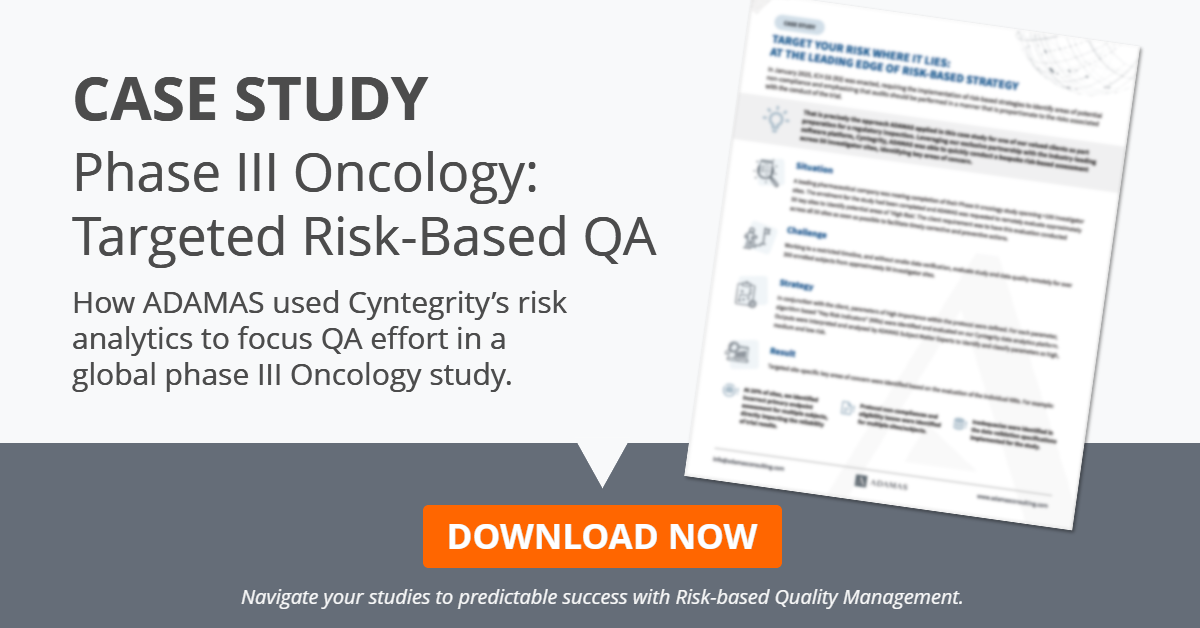Finding the Balance Between Monitoring Cost and Patient Safety
It is widely broadcasted that pharma companies will have to accelerate adoption of adaptive clinical trial designs to reduce study timelines and costs while increasing success rates. Risk-based Monitoring “Real RBM” integrates the Adaptive Monitoring (AM) process, which addresses all aspects of Quality Risk Management. The concept incorporates people, process and technology yielding the greatest impact on quality, effectiveness and savings.
One of the key aspects of the introduction of Risk-based Monitoring is the adaptation of the on-site monitoring activities to a controlled minimum without putting patients at risk. Now, how can that be accomplished without adding another major process and resource burden on the organization, whether a pharma, biotech or medtech company, or CRO?
Build Understanding of Processes and Data First
Prior to adapting the on-site monitoring, a sponsor company first has to have a sound understanding of the processes that can go wrong and the data that are key to the project or the study and thus have to be correct by all means.
Based on historical findings (for companies that do have such information available), such as audit findings, inspection findings, CAPA findings or simply delayed target dates, the study team or project team must assess those critical processes in addition to critical processes that went well in the past. For companies that just got started, it may be beneficial to look for external advice and build a framework of processes for Risk-based Monitoring.
The data points that are critical for a project or a study should also be identified by the project team or the study team. In most of the cases, those data points concern inclusion and exclusion criteria, demographics, the main efficacy data, the adverse events and the premature termination related data. For certain particular studies and indications, there may be other important data to be taken into account.
Second, Anticipate On-site Monitoring Adaptations
Once the risks have been identified, have been assessed and have been categorized (and all the decisions have been documented), a study can start. Now, when looking at the monitoring adaptation part only, what does that mean for an on-site monitor?
The adaptation of the monitoring activities can be multifold. First, one has to differentiate between source data verification (SDV), source data review (SDR) and also the more general aspects of monitoring a site. A major part of the on-site monitoring is usually being spent on SDV, i.e. this is the area where probably smart applications can help keeping a high level of quality while at the same time permitting a reduction of time on this task. Therefore, let us focus on the SDV process only for now.
The Adaptive Monitoring plan can for example ask for the first two patients enrolled at each site to be 100% SDV’d. For sites that are known to deliver high quality data and adhere to the protocol, based on e.g. prior studies, this may be adapted to only the first patient to be 100% SDV’d. The only every second or third patient has to be 100% SDV’d.
If the RBM application, however, identifies a particular issue in the data provided by the sites, the monitoring plan may have to be adapted such that after the second patient (or the first one at the more senior sites) also the third patient and the fourth patient may have to be 100% SDV’d.
In case the data quality for the first four patients is within the expected high-quality range, the adapted monitoring plan may state that from then onwards, only every fourth patient has to be 100% SDV’d.
The Adaptive Monitoring plan may, however, also identify data points that have to be 100% SDV’d in any case and for all patients, irrespective of the quality of the data at a particular site. Those data may be for example serious adverse event data, data related to the premature termination or any other data warranting a particular attention.
Conclusion: RBM and AM, One Doesn’t Go Without the Other
The worst-case scenario is probably one where a study has implemented a smart Risk-based Monitoring application, and the application identifies all the problem areas while at the same time, a 100% SDV is still being performed. Such a scenario defeats the purpose of the implementation of RBM and probably damages the original intent: i.e. reduce workload while keeping (or even elevating) the quality of the important data.
Therefore, when rolling out Risk-based Monitoring and when changing the underlying processes, one must do it right from the beginning and implement Adaptive Monitoring as well, as earlier described for the sub-process of SDV.
If you are interested in getting access to the Adaptive Monitoring process charts, then subscribe to our newsletter “Real RBM for All”. In the coming weeks I will guide you through the process of Adaptive Monitoring by providing you the complete process overview step by step. So stay tuned…







